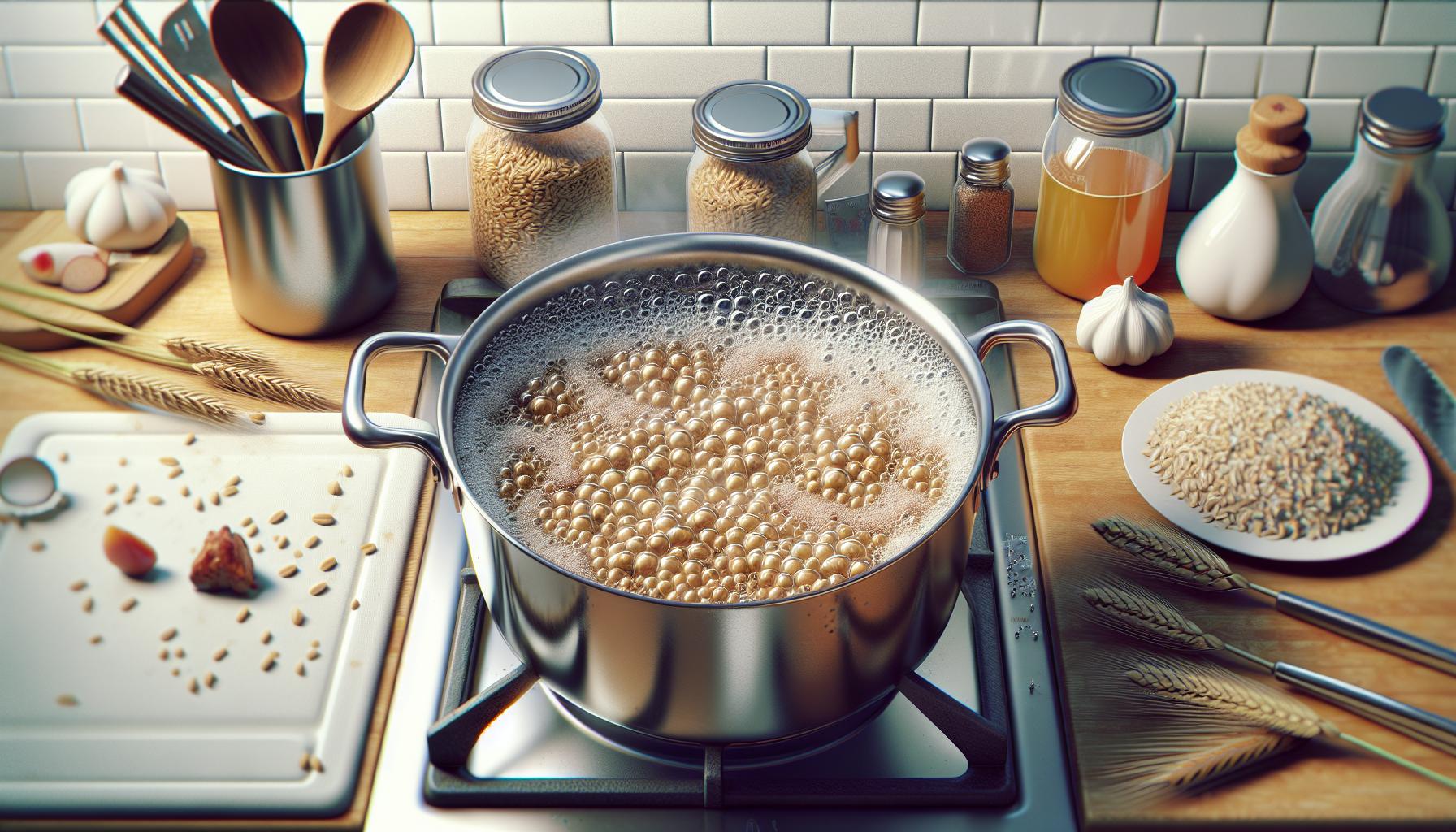Physical Address
304 North Cardinal St.
Dorchester Center, MA 02124
Physical Address
304 North Cardinal St.
Dorchester Center, MA 02124

Barley’s nutty charm and chewy texture have made it a beloved grain for thousands of years but many home cooks still find it intimidating. This versatile ancient grain isn’t just for soups and stews – it’s a nutritional powerhouse that deserves a starring role in countless dishes.
Whether pearled or hulled barley’s the star of the show knowing the right cooking techniques can transform this humble grain into a culinary masterpiece. From fluffy pilaf-style preparations to creamy risottos there’s a barley cooking method to suit every palate and recipe. The best part? It’s nearly impossible to mess up making it perfect for both kitchen newbies and seasoned chefs.
Barley comes in several distinct varieties, each with unique characteristics affecting cooking time, texture and nutritional content.
Pearled barley undergoes mechanical processing that removes its outer bran layer and hull, creating a faster-cooking grain with a lighter texture. This processing reduces fiber content but maintains a tender, chewy consistency ideal for soups and side dishes. Hulled barley retains its bran layer after removing only the inedible outer hull, preserving more nutrients and fiber. The intact bran gives hulled barley a nuttier flavor with 50% more fiber than pearled varieties. Cooking times differ significantly: pearled barley takes 25-30 minutes while hulled barley requires 45-60 minutes to reach optimal tenderness.
| Type | Cooking Time | Fiber Content | Best Uses |
|---|---|---|---|
| Pearled | 25-30 min | 3g per serving | Soups, sides |
| Hulled | 45-60 min | 6g per serving | Pilafs, salads |
Quick-cooking barley varieties offer convenience without sacrificing the grain’s essential qualities. These pre-steamed products reduce cooking time to 10-15 minutes while maintaining a satisfying texture. Instant barley flakes provide an even faster alternative, ready in 5 minutes with hot water. Multiple brands offer par-cooked barley products that deliver consistent results for time-conscious cooking. Quick-cooking varieties work especially well in breakfast porridges, grain bowls and cold salads.
| Quick Option | Cooking Time | Application |
|---|---|---|
| Pre-steamed | 10-15 min | All purposes |
| Instant flakes | 5 min | Breakfast, snacks |

The stovetop method provides a reliable way to cook barley with consistent results. This traditional cooking technique creates tender grains while maintaining their natural texture.
The optimal water ratio for cooking barley varies by type. Pearled barley requires 3 cups of water for every 1 cup of grain. Hulled barley needs 4 cups of water per 1 cup of grain, accommodating its longer cooking time.
| Barley Type | Water Ratio | Yield |
|---|---|---|
| Pearled | 1:3 | 3 cups cooked |
| Hulled | 1:4 | 3.5 cups cooked |
| Quick-cooking | 1:2 | 2 cups cooked |
Different barley varieties require specific cooking times for optimal results. Pearled barley cooks in 25-30 minutes. Hulled barley takes 45-55 minutes. Quick-cooking varieties finish in 10-15 minutes.
Testing for doneness involves:
A properly cooked barley grain maintains its shape while offering a tender bite. The liquid appears mostly absorbed with minimal moisture remaining at the bottom of the pot.
Pressure cooking transforms barley preparation by reducing cooking time up to 60%. Modern electric pressure cookers offer consistent results with programmable settings.
A pressure cooker prepares pearled barley in 15 minutes at high pressure followed by 10 minutes of natural release. Hulled barley cooks in 25 minutes at high pressure followed by 15 minutes of natural release. Adding 1 tablespoon of oil prevents foam buildup during the cooking process. Soaking barley for 4 hours before pressure cooking reduces the cooking time by an additional 5 minutes. The “multigrain” setting on electric pressure cookers automatically adjusts time temperature for optimal results.
The liquid ratio for pressure cooking barley differs from stovetop methods. Use 2 cups of liquid for every 1 cup of pearled barley 3 cups for hulled barley. Electric pressure cookers retain more moisture than stovetop models requiring less liquid overall. Opening the pressure cooker immediately after cooking creates firmer grains while natural release produces softer results. Testing doneness reveals properly cooked barley maintains distinct grains with a tender bite. Excess liquid indicates overcooking while dry tough grains signal insufficient cooking time or liquid.
Barley adapts beautifully to both pilaf and risotto cooking methods, creating distinct textures through specific techniques. These methods transform basic barley into sophisticated dishes with rich flavors and varied textures.
Traditional pilaf technique starts with toasting barley in oil or butter for 3-4 minutes until fragrant. Aromatics like diced onions garlic or shallots enhance the base flavor when sautéed with the grains. Adding warm stock or broth maintains consistent cooking temperature throughout the process. Pearl barley creates the ideal pilaf texture in 25 minutes when cooked at a gentle simmer with the lid on. A quick fluff with a fork after 10 minutes of resting separates the grains perfectly. Common pilaf additions include:
Barley risotto requires constant attention during the 35-minute cooking process. Small batches of hot stock (1/2 cup) get stirred into the toasted barley gradually. Stirring releases the starches creating a creamy consistency without cream. Pearl barley produces optimal results due to its starch content. Essential risotto elements include:
The finished dish displays individual grains suspended in a creamy sauce while maintaining their distinct texture.
Preparing barley through toasting or pre-soaking enhances its natural characteristics. These preparation methods create distinct flavor profiles while optimizing cooking efficiency.
Toasting barley intensifies its nutty flavor profile through the Maillard reaction. A 3-5 minute dry-heat treatment in a skillet transforms raw barley into aromatic grains with deeper complexity. The process creates a protective outer layer that helps the grains maintain their shape during cooking. Toasted barley adds robust notes to pilafs, salads, soups.
Key toasting benefits include:
Pre-soaking reduces cooking time for hulled barley by 15-20 minutes. The process activates enzymes that break down phytic acid, increasing nutrient absorption. A 4-8 hour soak in cold water works for regular cooking methods, while a 30-minute hot water soak suits quick preparations.
Optimal pre-soaking scenarios:
| Type | Soak Time | Water Ratio |
|---|---|---|
| Hulled | 8 hours | 1:3 |
| Pearled | 4 hours | 1:2 |
| Quick-cook | 30 minutes | 1:2 |
Cooked barley stays fresh in an airtight container in the refrigerator for 5 days. Storing barley in glass containers preserves its texture better than plastic alternatives.
Raw barley maintains peak freshness for 12 months when stored in an airtight container in a cool dark place. Vacuum sealing extends shelf life to 18 months while preserving nutritional value.
| Storage Method | Temperature | Duration |
|---|---|---|
| Pantry (raw) | 70°F/21°C | 12 months |
| Refrigerator (cooked) | 40°F/4°C | 5 days |
| Freezer (cooked) | 0°F/-18°C | 3 months |
Freezing cooked barley maintains optimal texture when cooled completely before transferring to containers. Thaw frozen barley overnight in the refrigerator for best results. Room temperature thawing creates excess moisture affecting grain texture.
Meal prep combinations include grain bowls with roasted vegetables mixed salads protein rich side dishes. Adding cooked barley to soups stews enhances texture thickness without additional cooking time.
Mastering barley cooking techniques opens up a world of culinary possibilities. Whether using traditional stovetop methods pressure cooking or exploring creative applications like pilaf and risotto the right technique ensures perfect results every time.
Armed with proper cooking ratios storage guidelines and preparation methods anyone can confidently incorporate this nutritious ancient grain into their meal planning. From quick weeknight dinners to batch cooking for future meals barley’s versatility makes it an excellent addition to any kitchen repertoire.
The journey to perfectly cooked barley is straightforward when following these time-tested techniques. It’s time to embrace this wholesome grain and discover its delicious potential in everyday cooking.